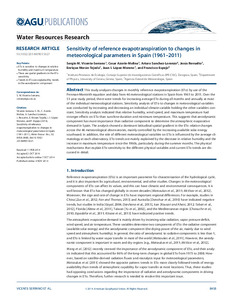Por favor, use este identificador para citar o enlazar este ítem:
http://hdl.handle.net/20.500.11765/11662
Sensitivity of reference evapotranspiration to changes in meteorological parameters in Spain (1961–2011)
Registro completo de metadatos
| Campo DC | Valor | Lengua/Idioma |
|---|---|---|
| dc.contributor.author | Vicente Serrano, Sergio Martín | es_ES |
| dc.contributor.author | Azorín Molina, César | es_ES |
| dc.contributor.author | Sánchez Lorenzo, Arturo | es_ES |
| dc.contributor.author | Revuelto, Jesús | es_ES |
| dc.contributor.author | Morán Tejeda, Enrique | es_ES |
| dc.contributor.author | López Moreno, Juan Ignacio | es_ES |
| dc.contributor.author | Espejo Gil, Francisco | es_ES |
| dc.date.accessioned | 2020-04-23T10:11:16Z | - |
| dc.date.available | 2020-04-23T10:11:16Z | - |
| dc.date.issued | 2014 | - |
| dc.identifier.citation | Water Resources Research. 2014, 50(11), p. 8458-8480 | es_ES |
| dc.identifier.issn | 1944-7973 | - |
| dc.identifier.uri | http://hdl.handle.net/20.500.11765/11662 | - |
| dc.description.abstract | This study analyzes changes in monthly reference evapotranspiration (ETo) by use of the Penman-Monteith equation and data from 46 meteorological stations in Spain from 1961 to 2011. Over the 51 year study period, there were trends for increasing average ETo during all months and annually at most of the individual meteorological stations. Sensitivity analysis of ETo to changes in meteorological variables was conducted by increasing and decreasing an individual climate variable holding the other variables constant. Sensitivity analysis indicated that relative humidity, wind speed, and maximum temperature had stronger effects on ETo than sunshine duration and minimum temperature. This suggests that aerodynamic component has more importance than radiative component to determine the atmospheric evaporative demand in Spain. The analysis showed a dominant latitudinal spatial gradient in the ETo relative changes across the 46 meteorological observatories, mainly controlled by the increasing available solar energy southward. In addition, the role of different meteorological variables on ETo is influenced by the average climatology at each observatory. ETo trends are mainly explained by the decrease in relative humidity and the increase in maximum temperature since the 1960s, particularly during the summer months. The physical mechanisms that explain ETo sensitivity to the different physical variables and current ETo trends are discussed in detail. | es_ES |
| dc.description.sponsorship | This work has been supported by the research project CGL2011-27574-CO2-02 financed by the Spanish Commission of Science and Technology and FEDER, and ‘‘Demonstration and validation of innovative methodology for regional climate change adaptation in the Mediterranean area (LIFE MEDACC)’’ financed by the LIFE programme of the European Commission. | es_ES |
| dc.language.iso | eng | es_ES |
| dc.publisher | American Geophysical Union | es_ES |
| dc.subject | Evapotranspiration | es_ES |
| dc.subject | Meteorological parameters | es_ES |
| dc.subject | Relative humidity | es_ES |
| dc.title | Sensitivity of reference evapotranspiration to changes in meteorological parameters in Spain (1961–2011) | es_ES |
| dc.type | info:eu-repo/semantics/article | es_ES |
| dc.relation.publisherversion | https://dx.doi.org/10.1002/2014WR015427 | es_ES |
| dc.rights.accessRights | info:eu-repo/semantics/openAccess | es_ES |
| Colecciones: | Artículos científicos 2010-2014 | |
Ficheros en este ítem:
| Fichero | Descripción | Tamaño | Formato | ||
|---|---|---|---|---|---|
| Vicente_Sensitivity o... | 2,56 MB | Adobe PDF |  Visualizar/Abrir |
Los ítems de Arcimis están protegidos por una Licencia Creative Commons, salvo que se indique lo contrario.





